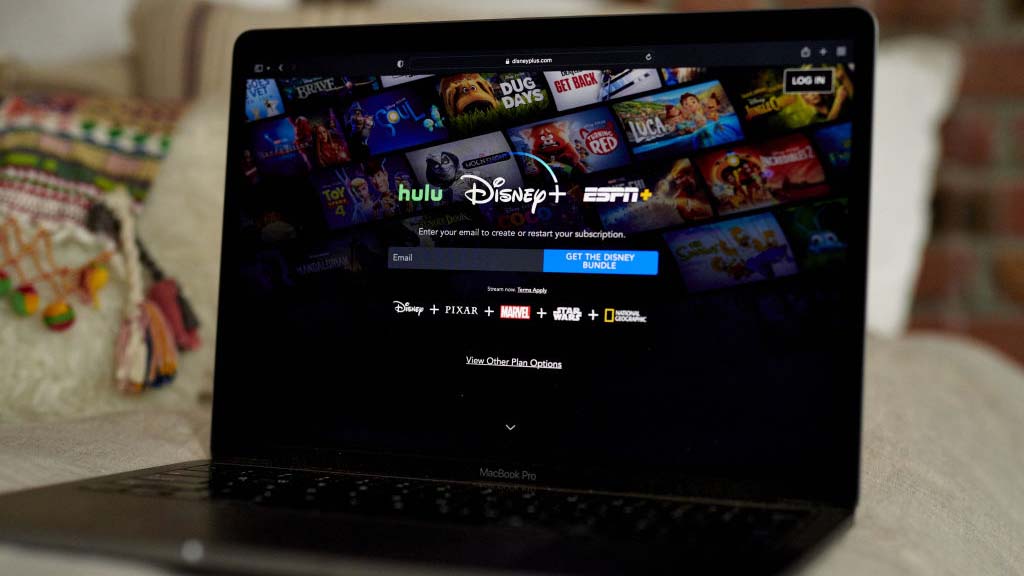Disney Entertainment DTC Business Gets Out of the Red in Q2
Disney Plus adds 6 million subscribers

After winning a proxy fight, The Walt Disney Co. said its entertainment business turned a profit and added subscribers in its fiscal second quarter.
Net income was down as the company wrote off Star in India, but Disney said its overall second-quarter performance was strong enough to increase its full-year earnings per share growth target to 25%.
The company added 6 million Disney Plus core subscribers, giving it 117.6 million in total.
Disney’s direct-to-consumer entertainment business generated positive operating income of $47 million in the quarter. A year ago, it lost $587 million. Cutting streaming losses has been a priority for media companies, which have been bleeding cash trying to catch up with Netflix.
Revenues rose 13% to $5.6 billion.
Disney said its DTC business improved because of subscription revenue growth as the company raised some rates. Distribution costs were down while advertising revenues were up.
The company said it expects entertainment DTC results to be “softer” in the current quarter because of the India business.
The smarter way to stay on top of broadcasting and cable industry. Sign up below
“We continue to expect our combined streaming businesses to be profitable in the fourth quarter, and to be a meaningful future growth driver for the company, with further improvements in profitability in fiscal 2025,” the company said.
Combined with ESPN’s streaming business, Disney lost just $18 million in its DTC business, with revenue climbing 12% to $6.1 billion.
The company had a net loss of $20 million, or 1 cent per share, for the quarter, compared to net income of $1.3 billion, or 69 cents a share, a year ago.
The results include a $2.1 billion charge for goodwill impairments related to Star India, which was folded into a new joint venture.
Excluding the charges, earnings per share were $1.21 vs 93 cents a year ago.
Revenues edged up 1% to $22.1 billion from $21.8 billion a year ago.
Disney’s entertainment segment increased operating income by 72% to $781 million. Revenue fell 5% to $9.8 billion.
Operating income for Disney’s linear networks was down 22% to $752 million. Revenue was down 8% to $2.8 billion.
Disney said domestic affiliate revenue was down because Charter now carries fewer networks under the carriage agreement reached last year.
Advertising revenues are down because of lower ratings, the company said.
The company reversed its DTC losses with $47 million in operating income on revenue of $$5.6 million. The company lost $18 million on content sales and licensing as revenue fell 40% to $1.4 billion.
Disney Plus added 8 million domestic subscribers to give it 54 million. It lost 1.6 million international subscribers (including Disney Plus Hotstar in India)
Hulu added 500,000 subscribers, increasing its total to 50.2 million. SVOD only subs increased by 700,000 to 45.8 million, which Hulu Plus Live TV lost 100,000 subscribers to end the quarter with 4.5 million customers.
Operating income fell 2% to $778 million at Disney’s sports division, including ESPN. Revenues were up 2% to $4.3 billion.
ESPN operating income was down 9% to $799 million as revenues rose 3% to $4.2 billion. Affiliate revenue was down, while advertising revenue was up. Subscription revenue for ESPN Plus increased because of higher rates.
Disney’s experiences segment, including theme parks, grew its operating income by 12% to 2.3 billion, Revenues were up 10% to $ 8.4 billion.
“Our strong performance in Q2 … demonstrates we are delivering on our strategic priorities and building for the future,” CEO Bob Iger said.
“Our results were driven in large part by our Experiences segment as well as our streaming business. importantly, entertainment streaming was profitable for the quarter, and we remain on track to achieve profitability in our combined streaming businesses in Q4,” he said. “Looking at our company as a whole, it’s clear that the turnaround and growth initiatives we set in motion last year have continued to yield positive results.”
Jon has been business editor of Broadcasting+Cable since 2010. He focuses on revenue-generating activities, including advertising and distribution, as well as executive intrigue and merger and acquisition activity. Just about any story is fair game, if a dollar sign can make its way into the article. Before B+C, Jon covered the industry for TVWeek, Cable World, Electronic Media, Advertising Age and The New York Post. A native New Yorker, Jon is hiding in plain sight in the suburbs of Chicago.

